In addition to causing huge societal change, Covid-19 has acted as massive accelerant in our use of technology – which has leapfrogged several years in a matter of months.
The changes – rapid and far-reaching as they seem – are in reality a continuation of trends that have been in motion for years especially in areas such as Ecommerce and Digital Transformation. But there is little doubt as to the scale of tech changes on society and business.
The power and influence of Social media was also thrust into the spotlight as the Covid crisis increased people’s use of social platforms for news and political factionalism.
In my latest blog post, I review some of the key developments of social media in 2020, with a focus on:
- Infodemic – Information wars about the pandemic
- Social media use in 2020 – how did it change.
- Examples of Irish businesses that excelled during lockdown
- Big Bad Tech – How social media is centre stage in political war and the huge issues it creates

Role of Social Media in the Pandemic – The ‘Infodemic’
The key properties of social media – its immediacy, viral nature and ease of publishing – made it the perfect vehicle disseminate spread news about the relentless spread of Covid-19.
More than year after brave medical staff in Wuhan Province took to social media to warn people across the world about human-to-human transmission of Covid, it’s clear social platforms have had a massive impact on public perceptions and debate about the virus.
In a world where everyone is a publisher, social media has allowed billions of people across the globe to comment and inform, but equally to spread disinformation, creating heightened confusion and fear about the virus.
According to the MIT Technology Review, the coronavirus pandemic has been the “the first true social-media ‘infodemic’ meaning ”an overabundance of information—some accurate and some not—that makes it hard for people to find trustworthy sources and reliable guidance when they need it.”
As the virus spread outside Wuhan, fierce debate raged across social media on all facets of the virus – from possible sources, to mortality rates to the severity of government restrictions. A blend of conspiracy theories, fake news and alarmist conjecture made it more difficult for people to gain a reliable perspective.
And that’s not to absolve editorial news media from stoking a heightened sense of fear and negativity during the Pandemic. There’s no doubt that while some news publishers took a more level-headed approach to their reporting, others unfortunately served to feed into the maelstrom of fear-mongering and hyperbole.
Social media platforms served as perfect vehicles for a more distorted narratives – with amplified ‘news’ from a motley crew of covid deniers, anti-vax propaganda and hostile state fear.
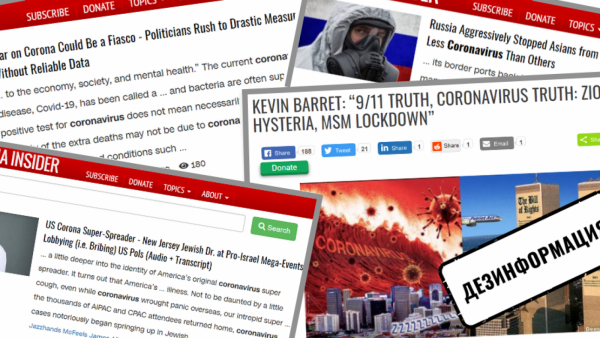
On the later point – the Pandemic has also provided a catalyst for the increased weaponization of misinformation on social media by authoritarian governments. There’s certainly more evidence of Russian and Chinese governments working to use social media to create confusion and discord in western states, and according to a leaked European Union’s diplomatic service that concluded “Pro-Kremlin media outlets have been prominent in spreading disinformation about the coronavirus, with the aim to aggravate the public health crisis in western countries, specifically by undermining public trust in national healthcare systems.”
The increasingly fractious environment has led to Social Media companies increasing its policing of what they see as disinformation and block factually incorrect health advice and claims. An uncomfortable position that social media companies have long feared, as they battle to stop their classification as publishers – and as we shall see later in the blog post – a battle they appear to be losing!
Use of Social Media During the Pandemic
There’s no doubt that social media use during the Pandemic rocketed as more people used platforms to consume news and communicate with friends
Numerator, a consumer insights company, published interesting research highlighting the changes on how people are using social media and what they are using each SM platform for.
Some of the stand out points include:
- A massive 66% of people have increased their use of SM during the Covid restrictions
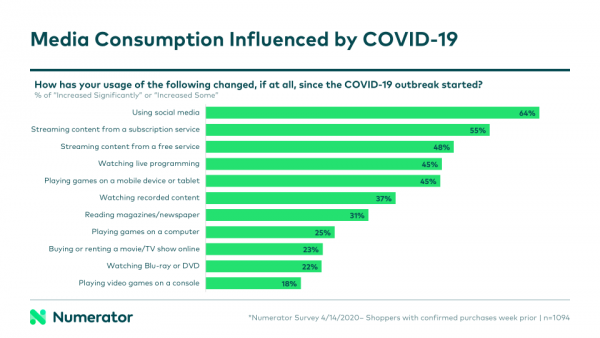
Staying Connected with Family and Friends
- The main reason why people were using social media – was to socialise with family and friends.
- All the Facebook platforms – FB, Insta and WA – the main platforms for socialisation!!
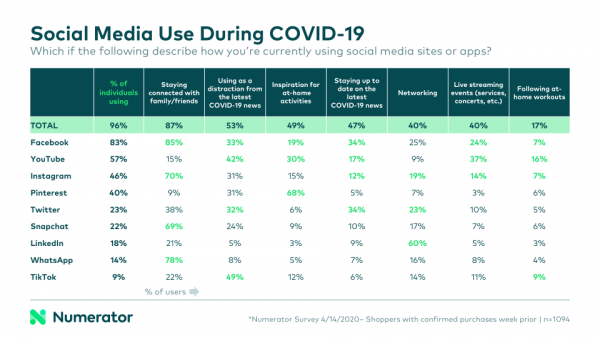
Social Media as a Distraction from Covid News
- A huge jump in the volume of people who were using SM as a distraction to get away from Covid news – with more than half of us do this
- The key networks for distraction were Facebook, You Tube and Tiktok
Linkedin – THE Business Community
The niche platform that outperformed during Lockdown was Linked. Linkedin’s use has increased dramatically in the past year– over 25% – as more people in business see it as the main online location for networking and engaging with other businesses.
How Businesses Reacted to Covid Restrictions
As well as presenting an operational nightmare for businesses across the globe, firms also had to quickly and carefully adapt how they communicated.
Overall, there tended to be a much greater focus on:
- Tone: Showing a kinder, more personal approach
- Relevancy: The challenge of things to talk about and how to stay relevant in a world where the Pandemic dominated everything.
- Transparency: Visually highlighting how their brands are adapting to Covid restrictions – across working from home, safety on premises and operational impact.
And with challenges came opportunities. Many businesses stood out by creating and sharing great content based on the three core areas highlighted above – tone, relevancy and transparency.
Let’s look at two Irish businesses that showed great innovation with their SM content: Lidl Ireland and Nevin Maguire
Lidl Ireland – Engaging, Relevant Content; Use of Facebook Instant Experience
Content
For a long time Lidl Ireland has really stood out for its excellence in PR, Communications and Social Media. If you want a great example of social media best practice in retail – I’d really recommend checking out their content on Facebook in particular. Throughout the Covid crisis, the brand delivered a very strong mix of content and engagement focussing on :
- Positive news stories – Shouting out to suppliers, new products stories, environmentalism
- Reinforcing Covid safety measures
- Home Cooking ideas: Especially the Cocktail recipes ; )
- Spotlight on Irish products in-store
- Health and Wellbeing advice via it’s ‘Operation Transformation’ video series
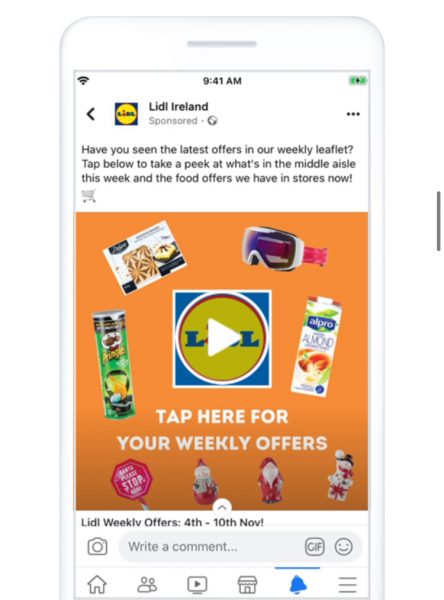
Use of Facebook Instant Experience
Lidl Ireland also acted to quickly digitise its printed leaflets using Facebook Instant Experience
Facebook Instant Experience is an “immersive full-screen ad is optimised for mobile and designed to capture the complete attention of an audience. Within an Instant Experience, people can watch videos and photos, swipe through carousels, tilt to pan and explore lifestyle images with tagged products—all in a single ad”.
The activity resulted in a 10X return on ad spend and a 2.3% increase in overall turnover at trial stores in Ireland.
Nevin Maguire – Utilising the latest lessons on home cooking !
Neven Maguire has always been excellent on social media with great use of video demos of his favourite dishes. However, he really moved up a gear during Lockdown when people across Ireland were crying out for cooking tips and inspiration.
Neven provided a steady stream of quality content that utilised Reels and IGTV on Instagram, mixed with some social media flashbacks that never felt tired.
But it was his revelation in January 2021 that he was a Techno DJ in his student days that really set feeds on fire! Neven was able to show a personal and fascinating side to his life that people really warmed to. “When the oven goes off, the decks come out!!” said Joe.ie
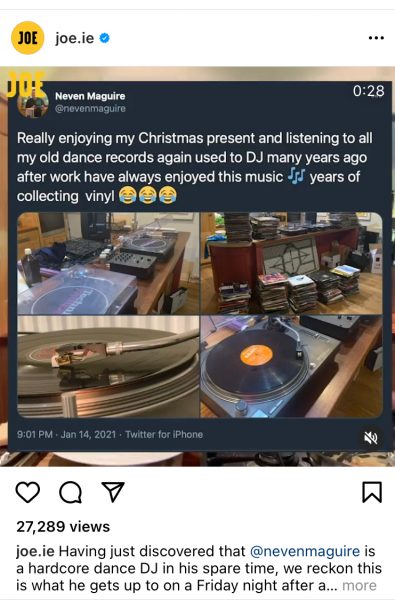
Tech on the ideological front line !
2020 was the year that Big Tech was firmly placed in the ideological frontline.
Across the world there’s been a huge upheaval in politics with increasingly bitter debates around culture wars, populism and nationalism been played out on social media. Now Social Media platforms face an existential crisis as they are forced to police waring factions and react to misinformation across their networks
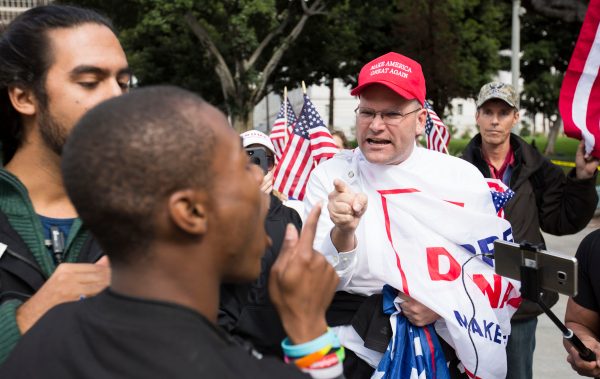
There’s no doubt Social media companies are now being forced into the role of publishers – something there been trying to avoid since their creation.
Big Tech now wields enormous power over the reach and impact of political ideas, debate, news and indeed the future of democracy. Established governments from the EU to UK and the United States are now increasingly uneasy about this power, and have pushed forward with advanced plans to curb it. Governments are now scared of the power of major tech firms in a way they weren’t five years ago.
And in 2020 they’ve started to do something about it. In 2021 we’ll see greater pressure on governments to begin the process of trying to break up with your tech firms based on monopolies legislation
The debate leaped forward considerably in January 2021 following the ‘insurrection’ on Capitol Hill, resulting in Donald Trump’s suspension from major social media networks. The CEOs of major social media platforms have now been thrust (unwillingly!) into the position of ultra-powerful, political media barons with huge power on who gets to appear on their platforms and what types of actions or views are, and aren’t allowed.
Looking forward, 2021 will see a much greater push to change to law to strip social media and other Big Tech firms of their powers – and will be much more transparent about their policies and decisions.
Social media Backlash: Celebrities Withdraw from Social Media
The past year has also witnessed a greater disengagement from social media in response to negativity, nastiness and trolling – spearheaded by a number of artists and celebrities.
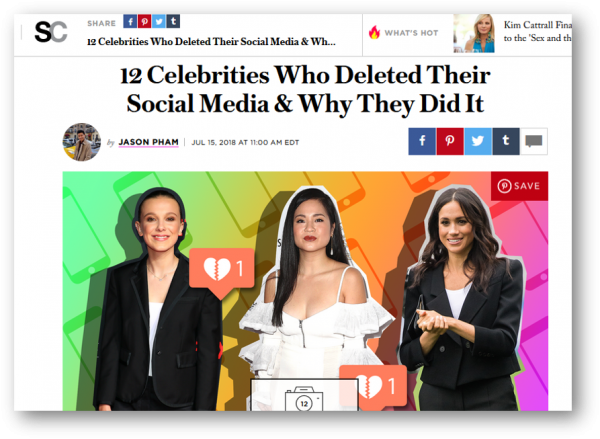
In Jan 2021 – Harry and Megan joined a growing list of Celebs which have quit social media including George Clooney and Scarlet Johansson. For some, there’s undoubtably more mystique in being much less publicly transparent, however for most celebs that have turned their back on social media – it’s due to the fact that the ‘risk / reward ratio’ now longer works in their favour!
Indeed, Mila Kunis summed up the experience well stating: “It all became all about who can be the loudest, the angriest and the most negative. It’s just not a fun game anymore.”
The Rise of Tik-tok
2020 was the year that TikTok took the social media world by storm.
Indeed, the rise of TikTok provides a fascinating insight into the evolution of social media and in particular how young people are using it to express themselves and socialise.

Although Tik-Tok was fast increasing its user base from 2018 onwards , the scale of the increase in 2020 was huge and it’s now become one of the key social media networks for young people.
So for anyone unfamiliar with TikTok – it’s a social media network that is dedicated to people taking the sharing short lip synced videos based on music, talent and even comedy. If you’re thinking it’s similar to other social media channels then you’re wrong.
In fact, a lot of people don’t understand the culture and environment of young people on TikTok and in reality, its environment is quite unique. Overall, it’s got a much greater focus on people as performers and a positivity about people expressing themselves. In comparison to other social media networks it’s more fun and much less negative than other platforms – which are major reasons why young people have flocked to it.
Expect TikTok to have a massive impact on the evolution of other social media platforms in 2021. We’ve already seen its impact on Instagram with the arrival of Reels – the new way to record and share 15 second clips set to music – and there’s no doubt its popularity will shape other networks!
by Paul McGarrity
